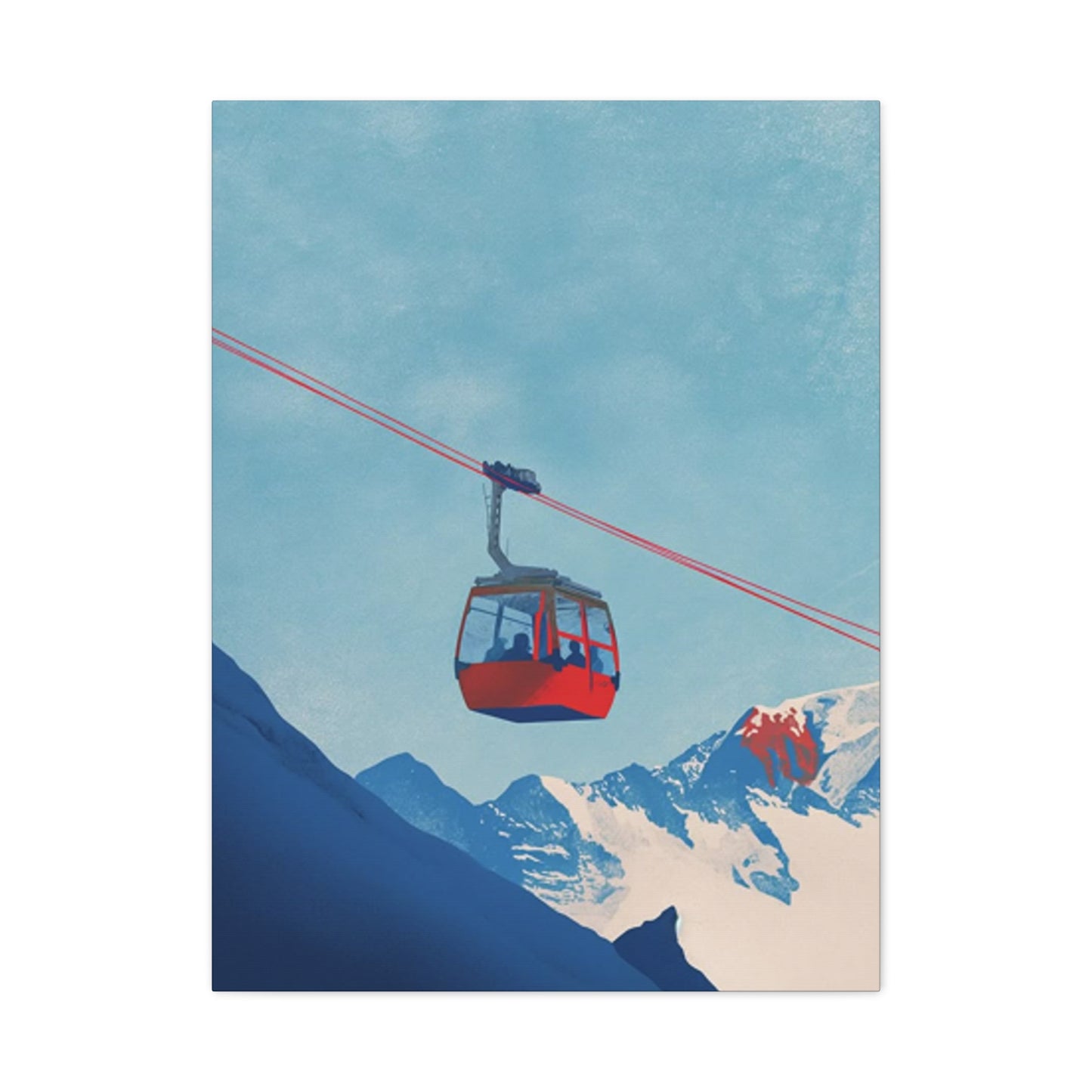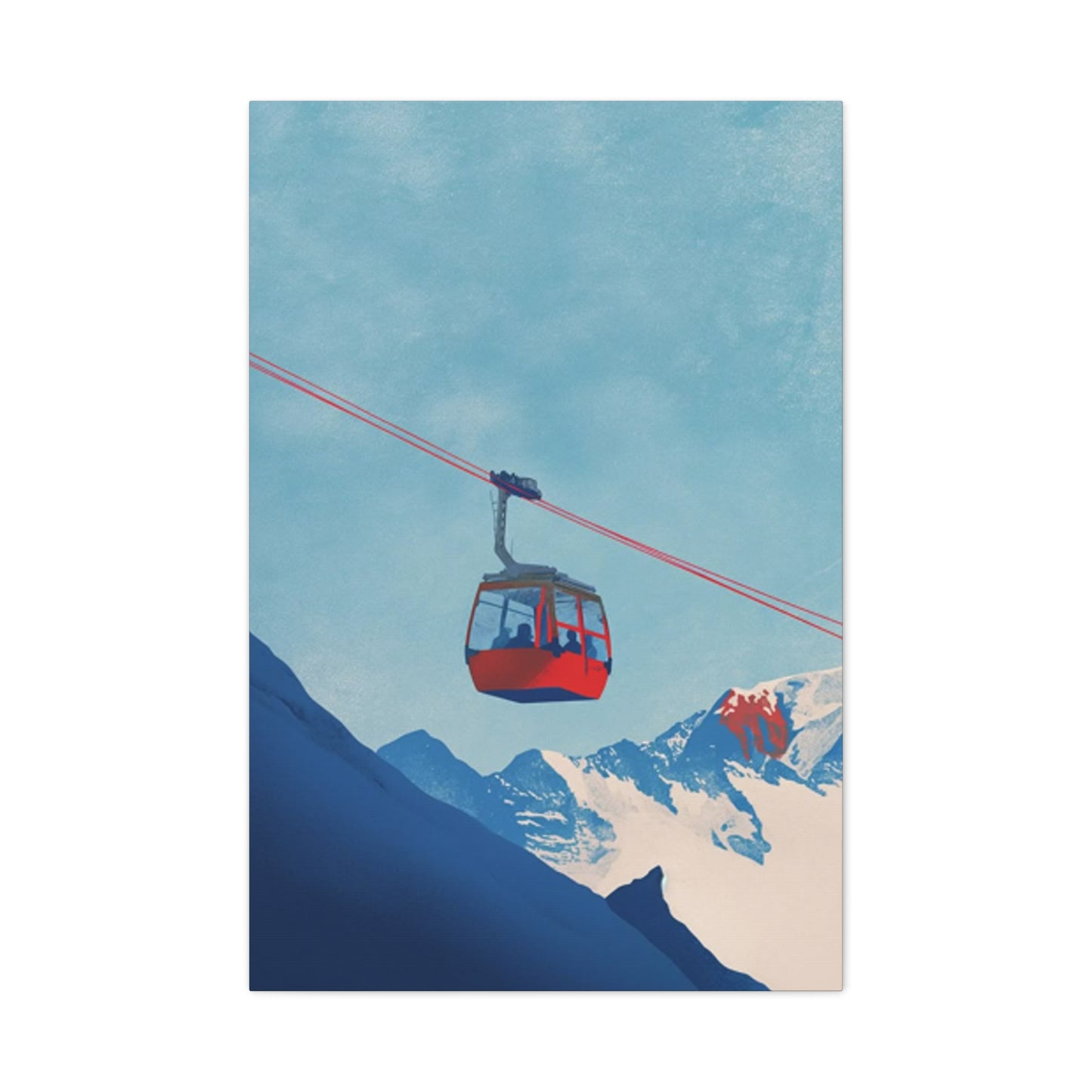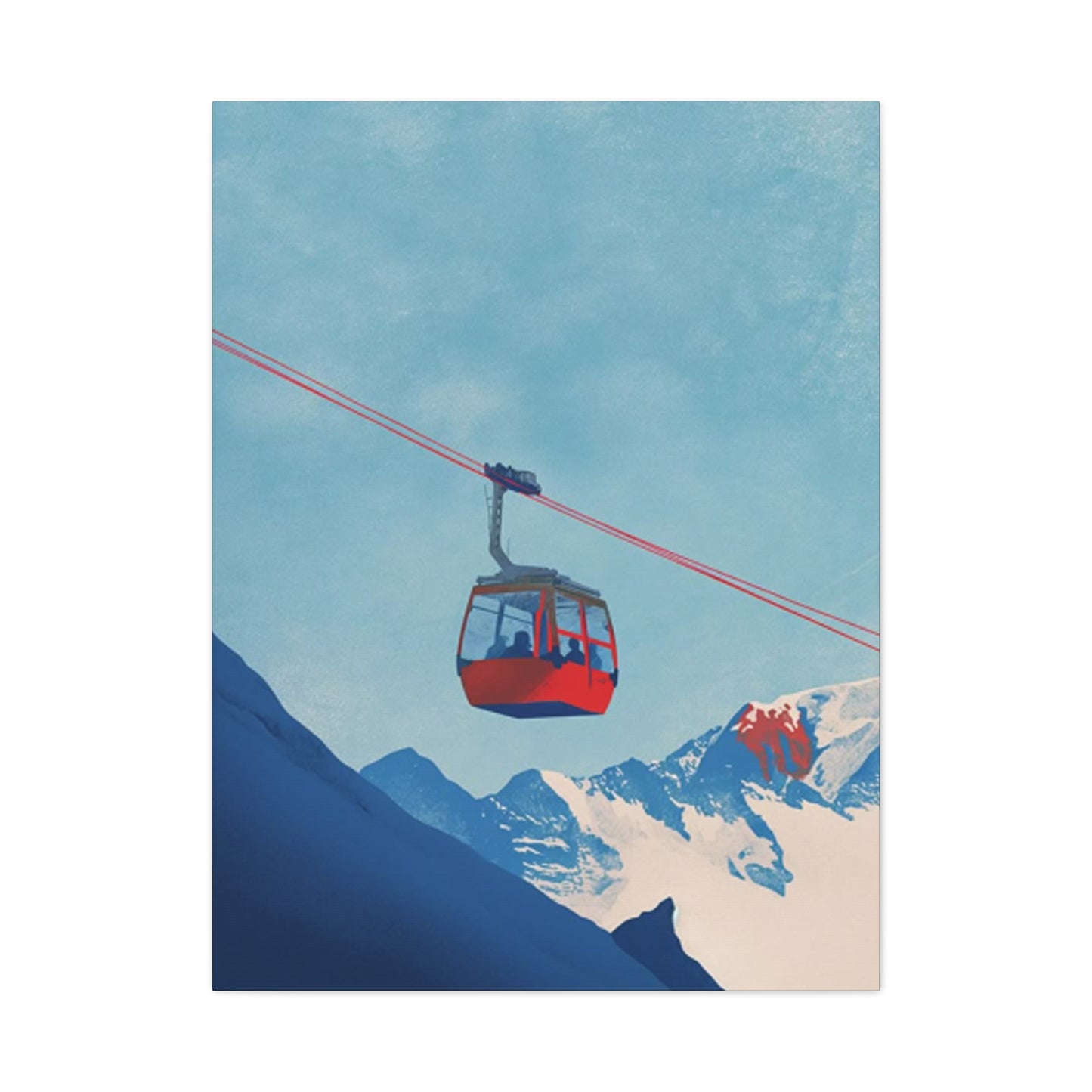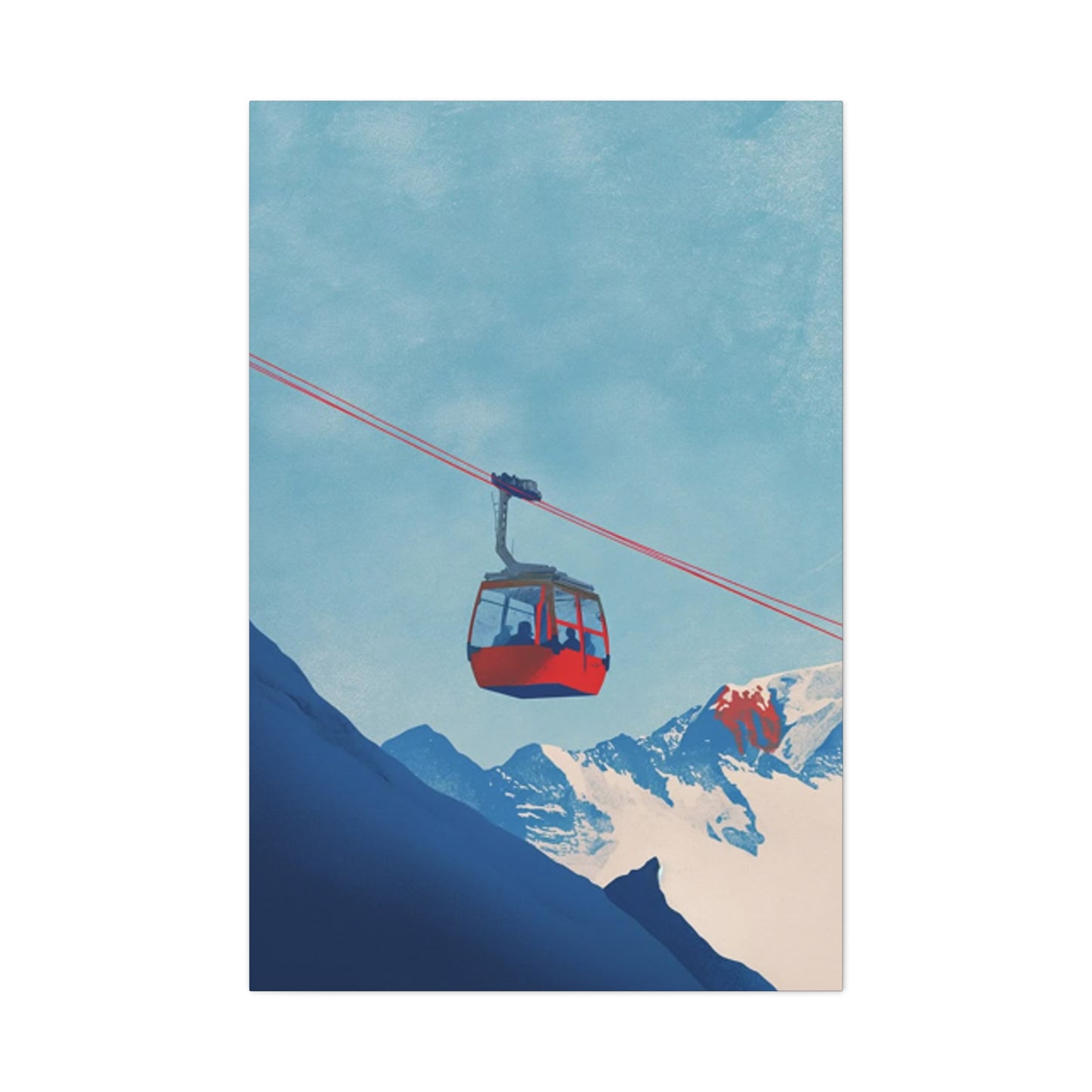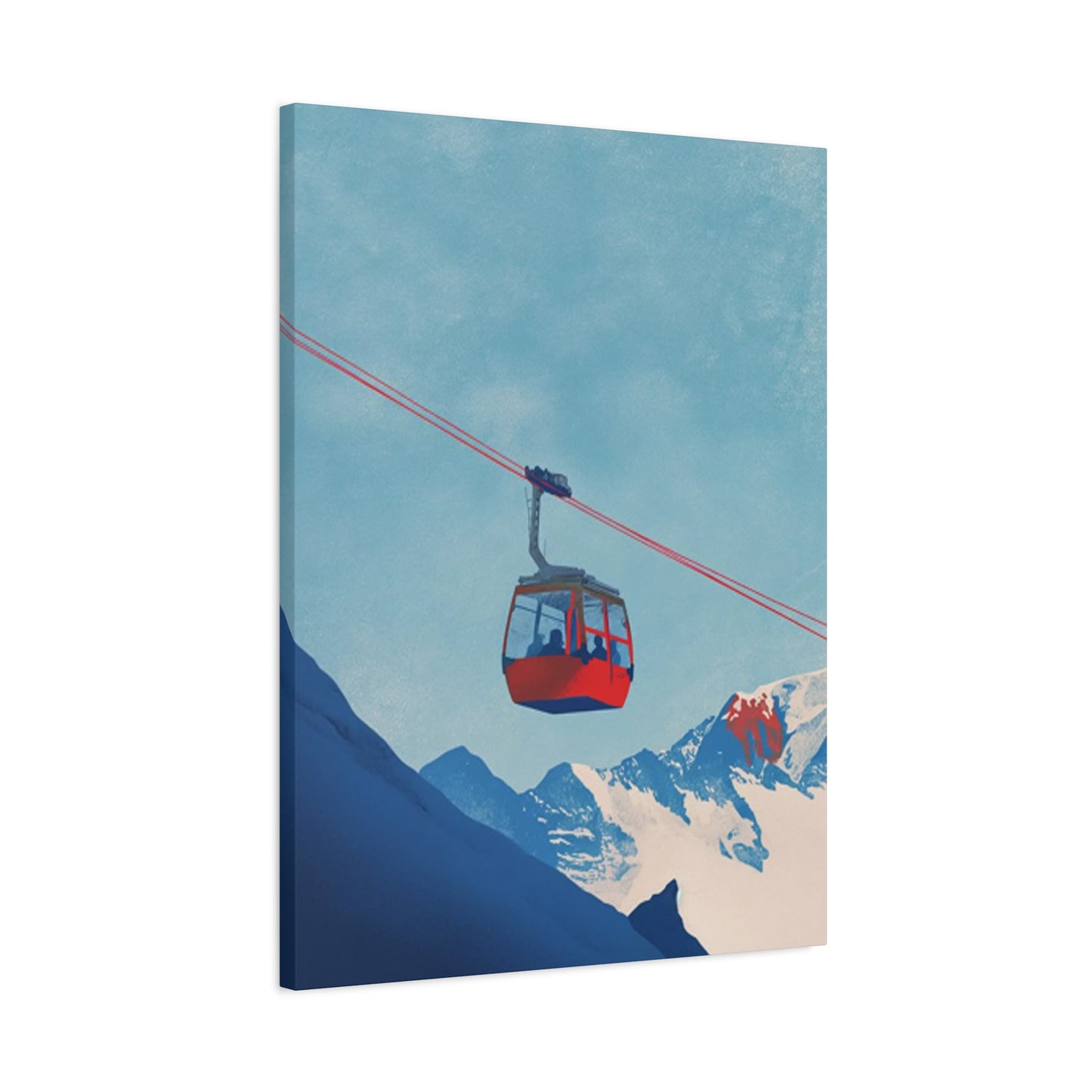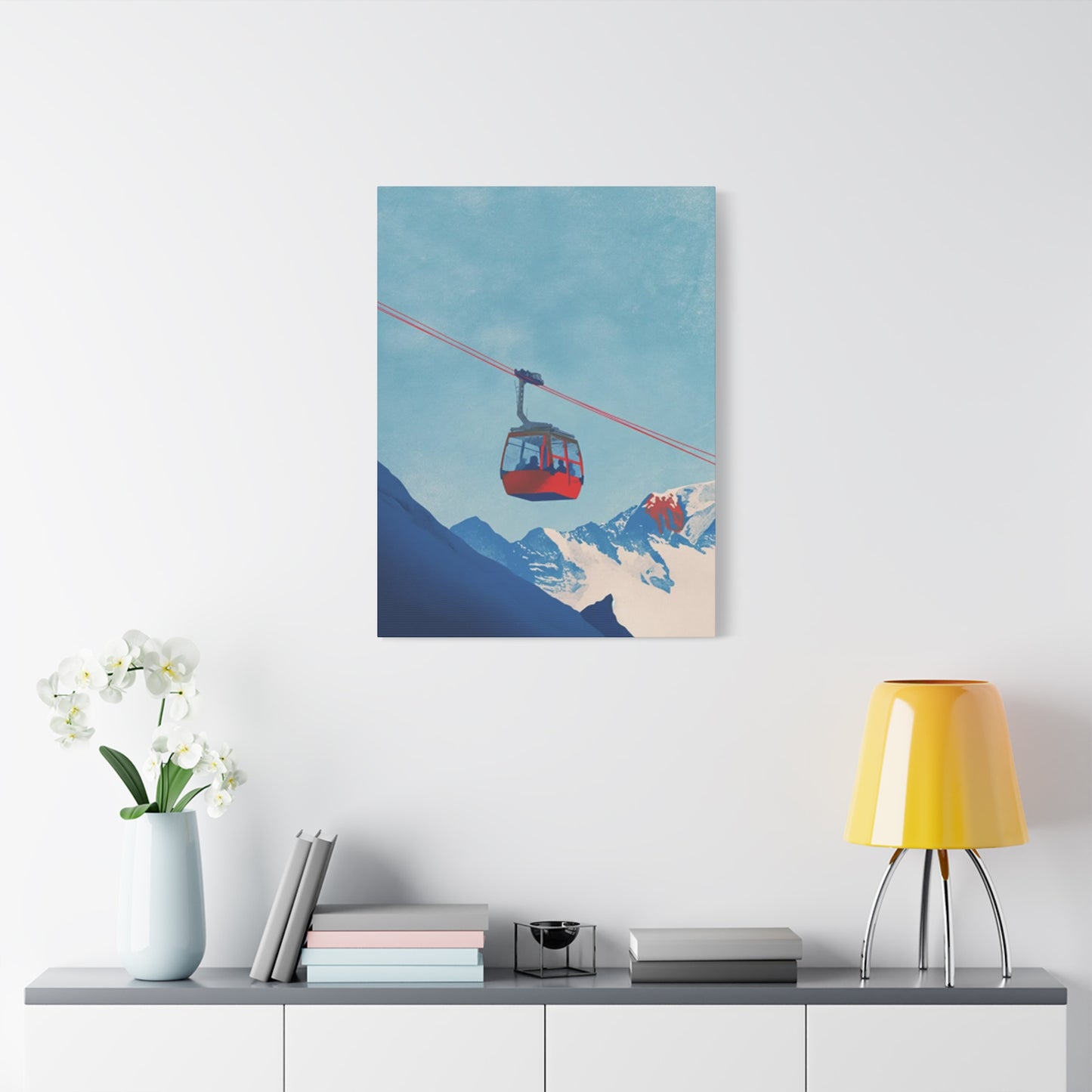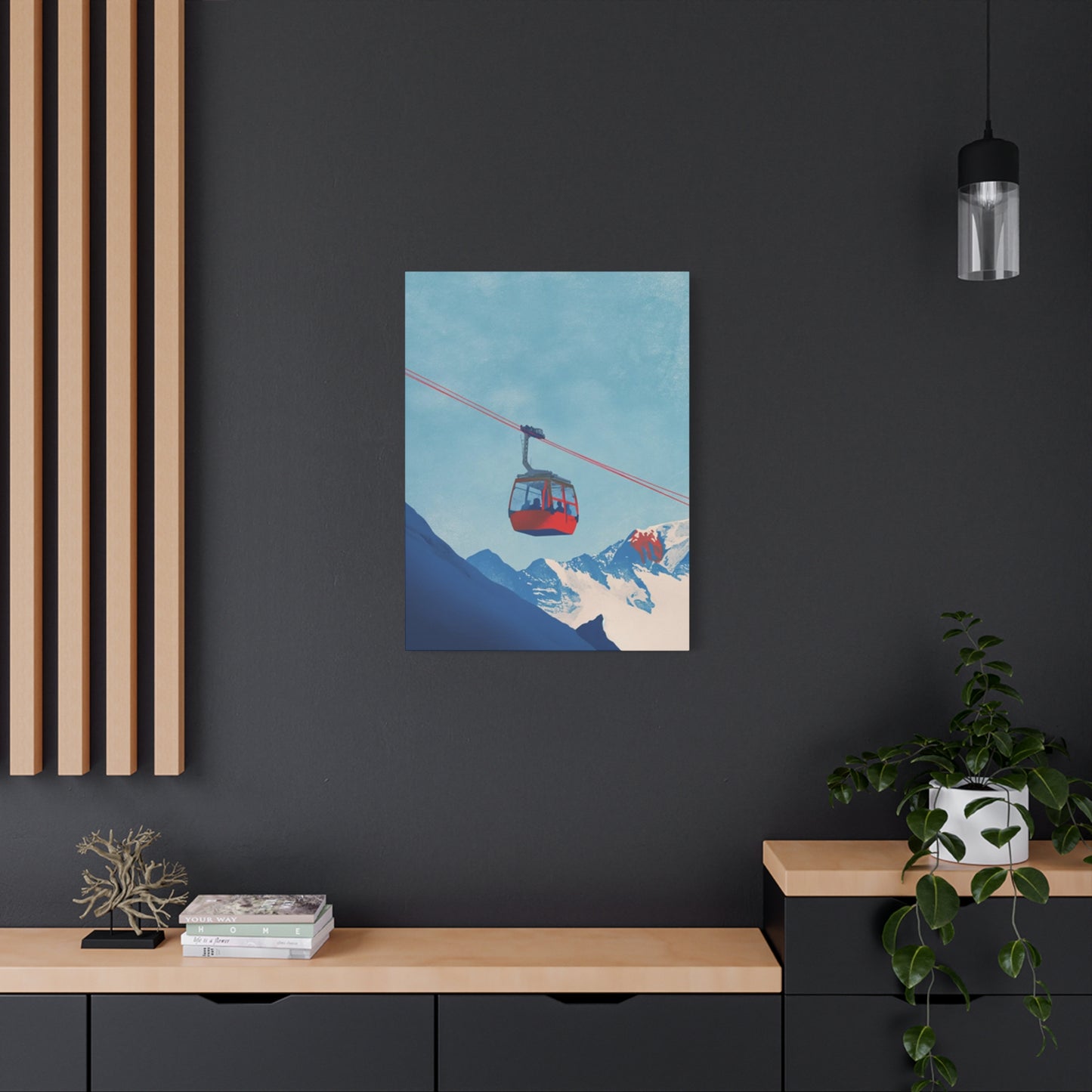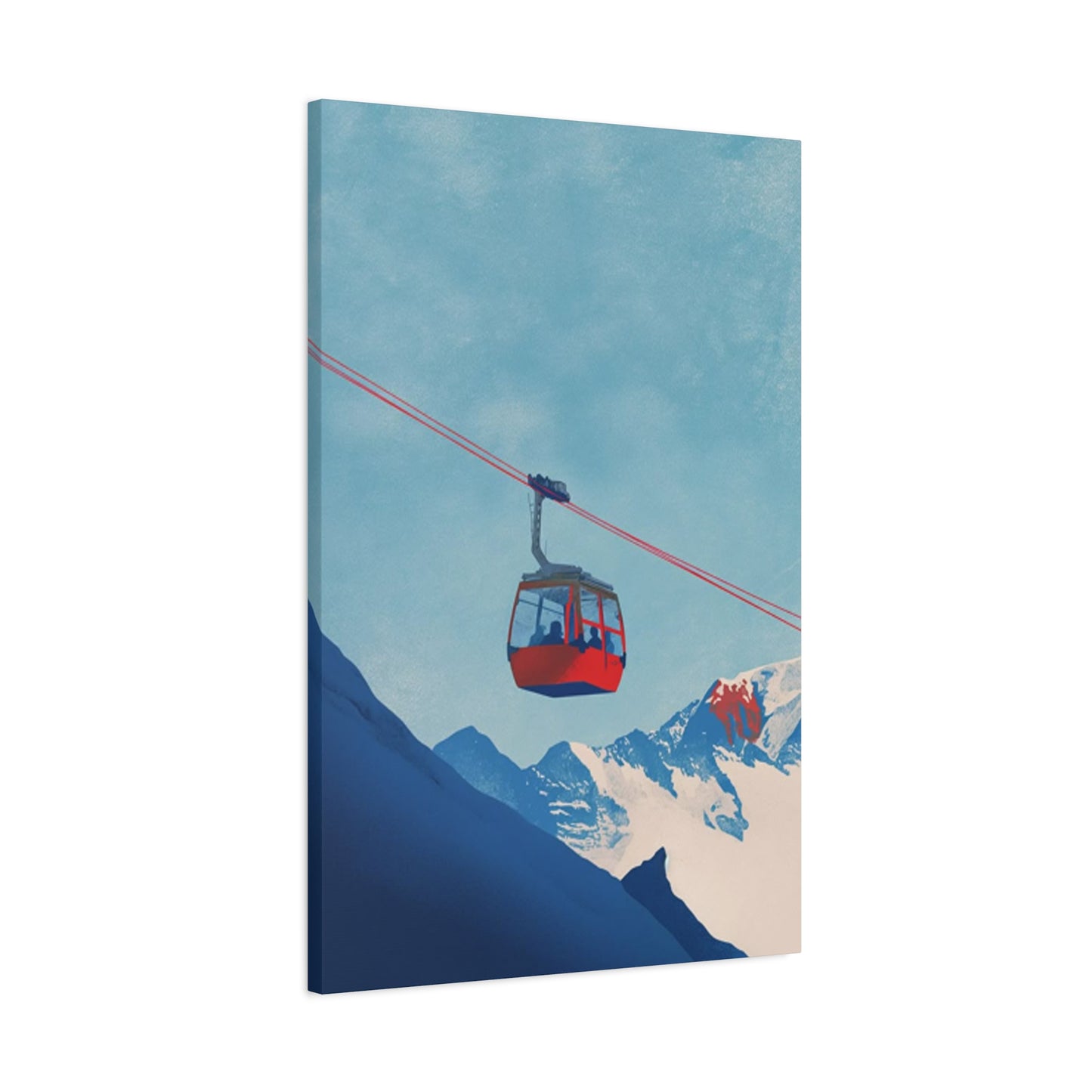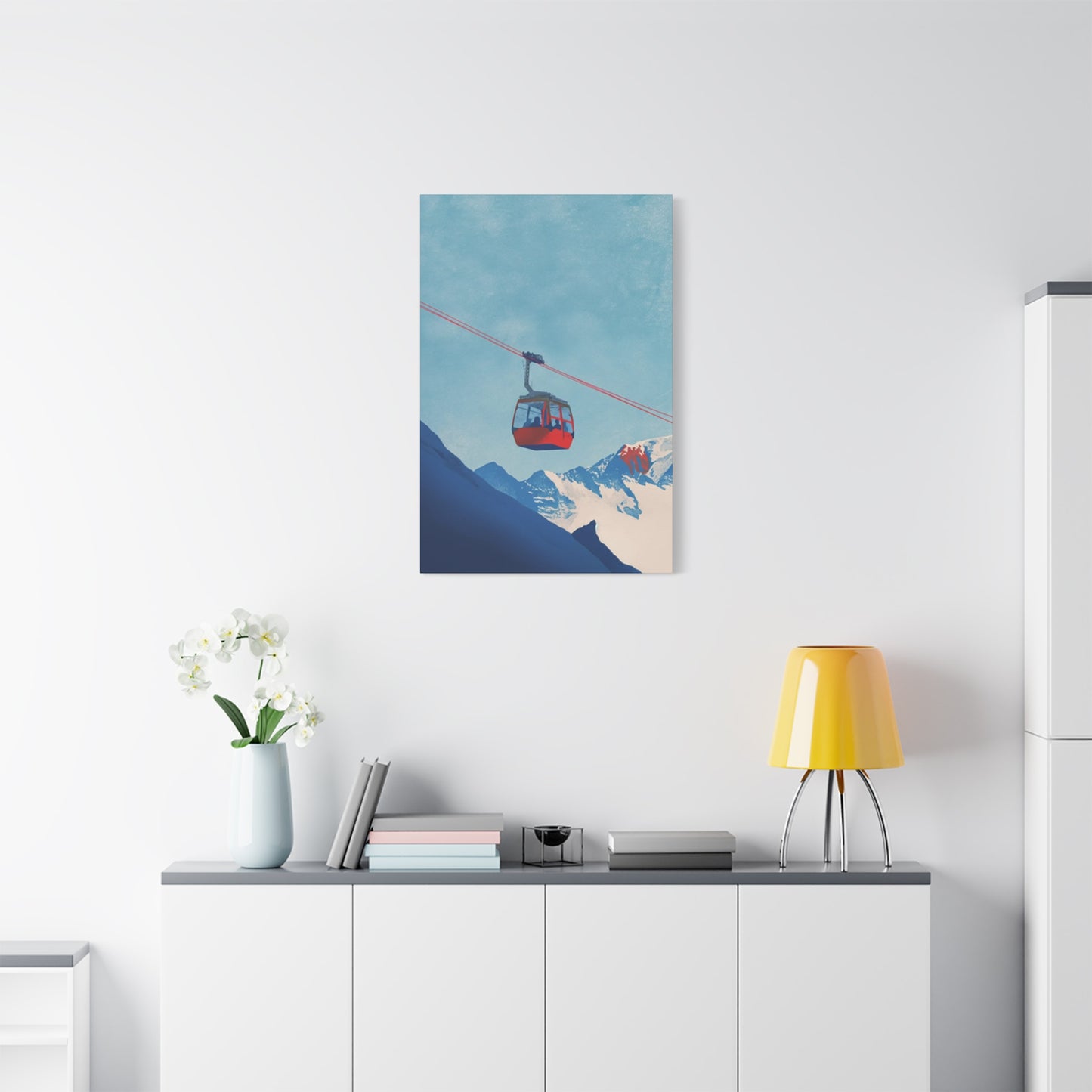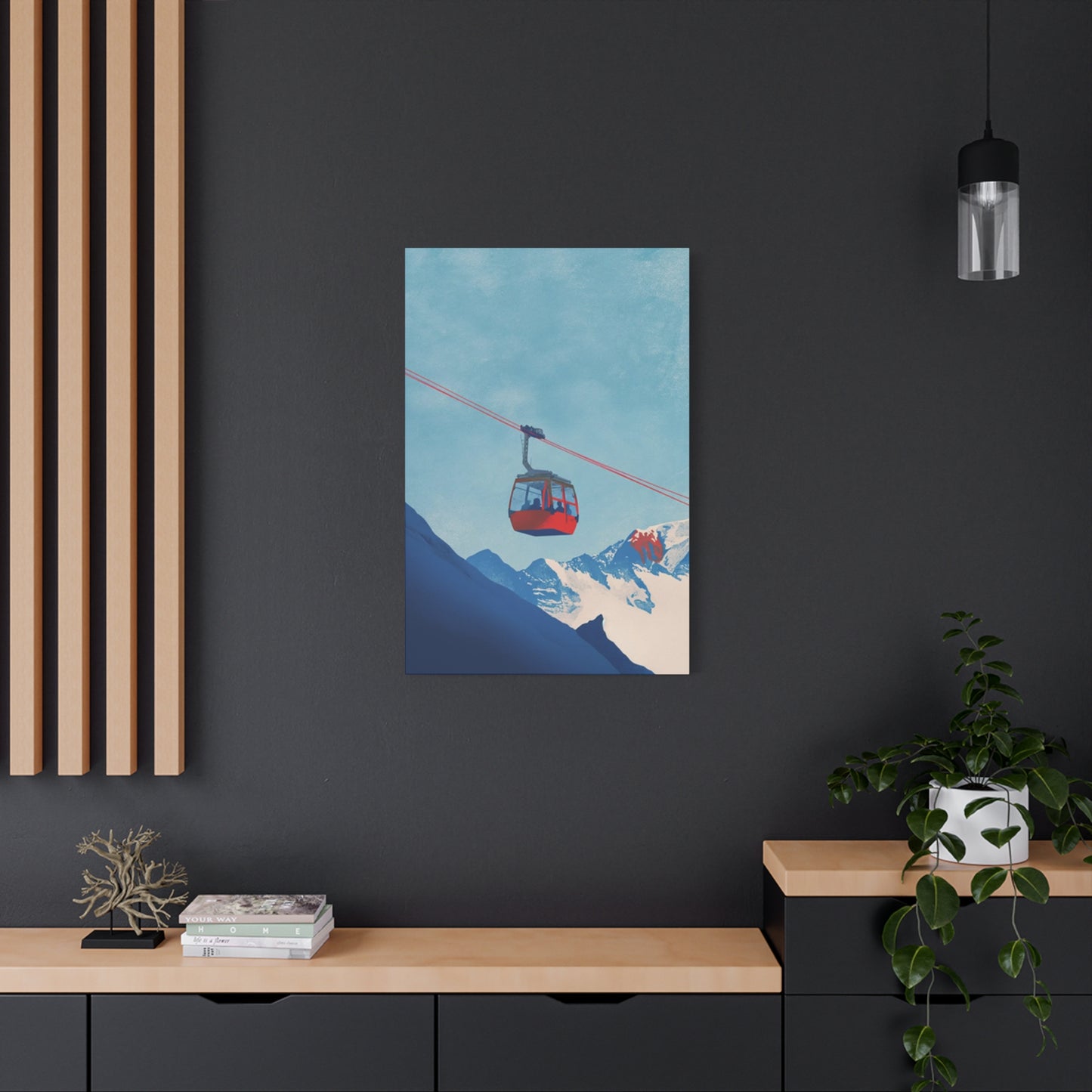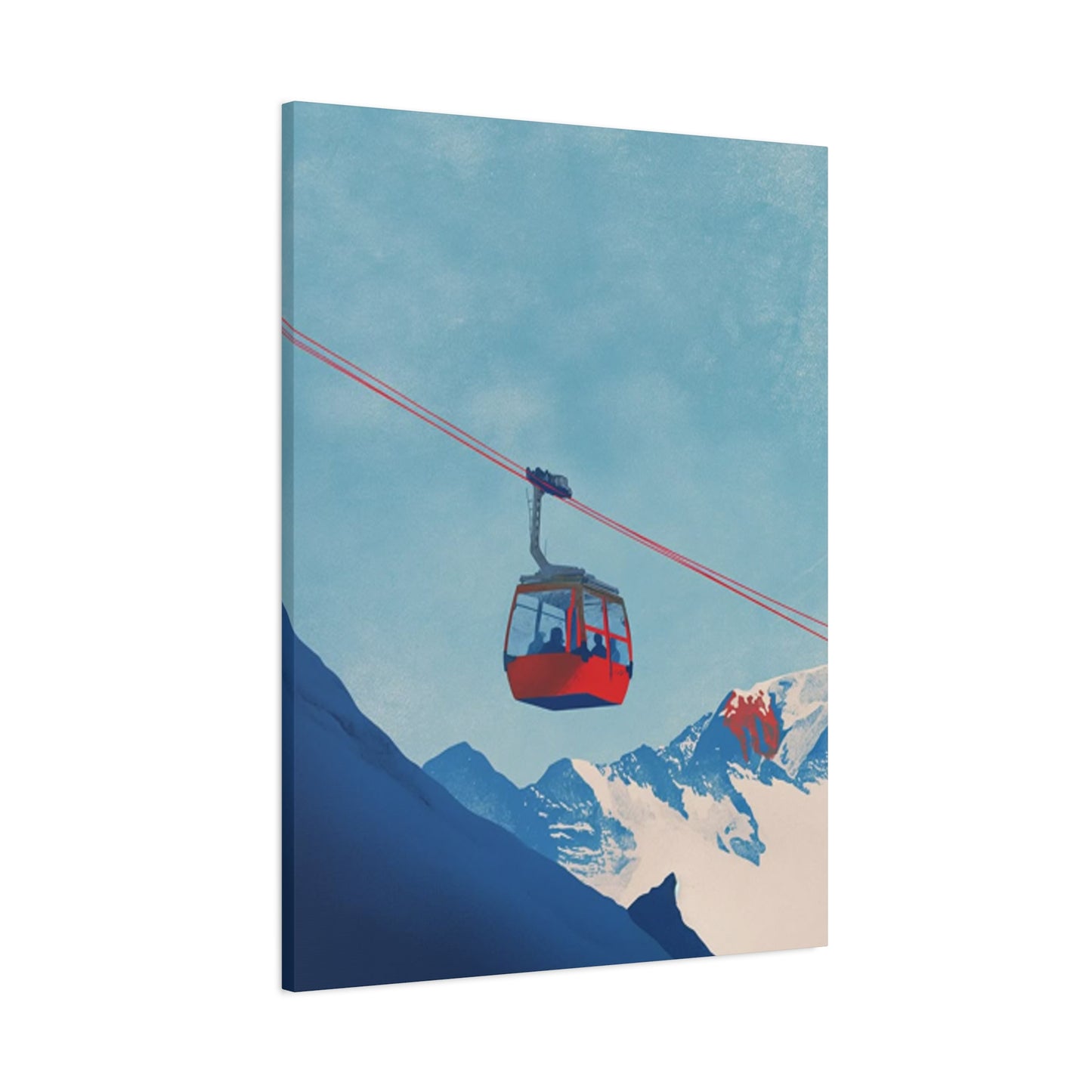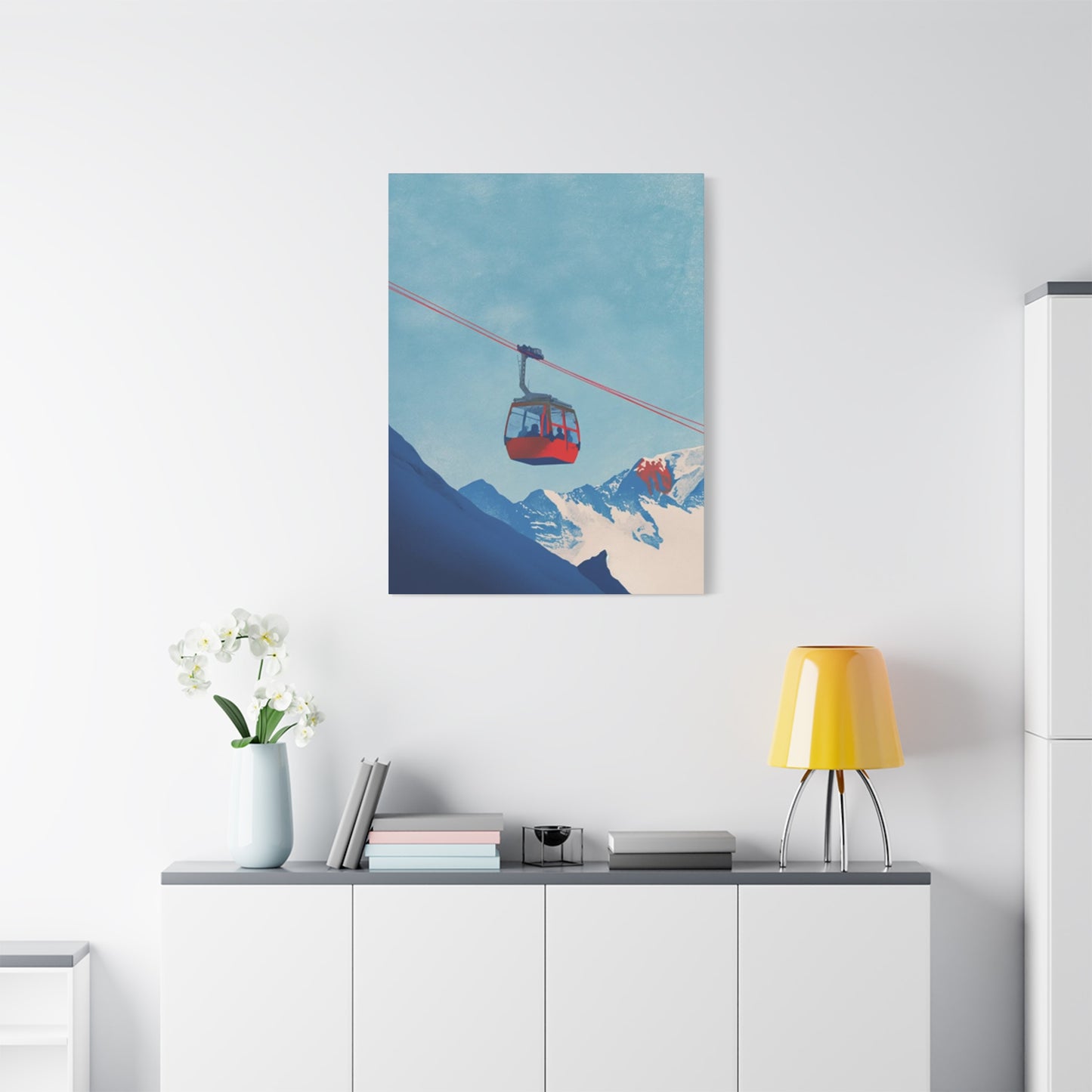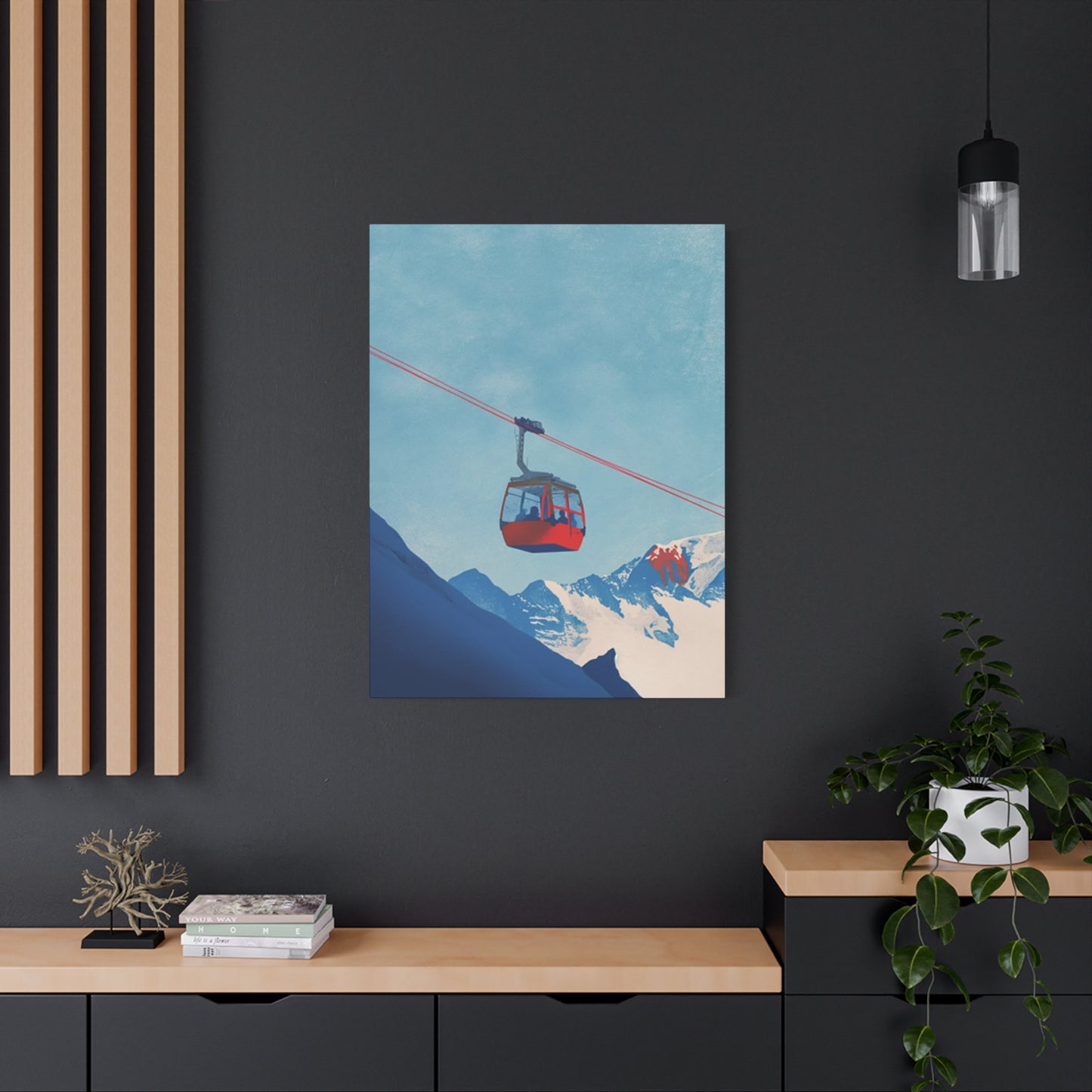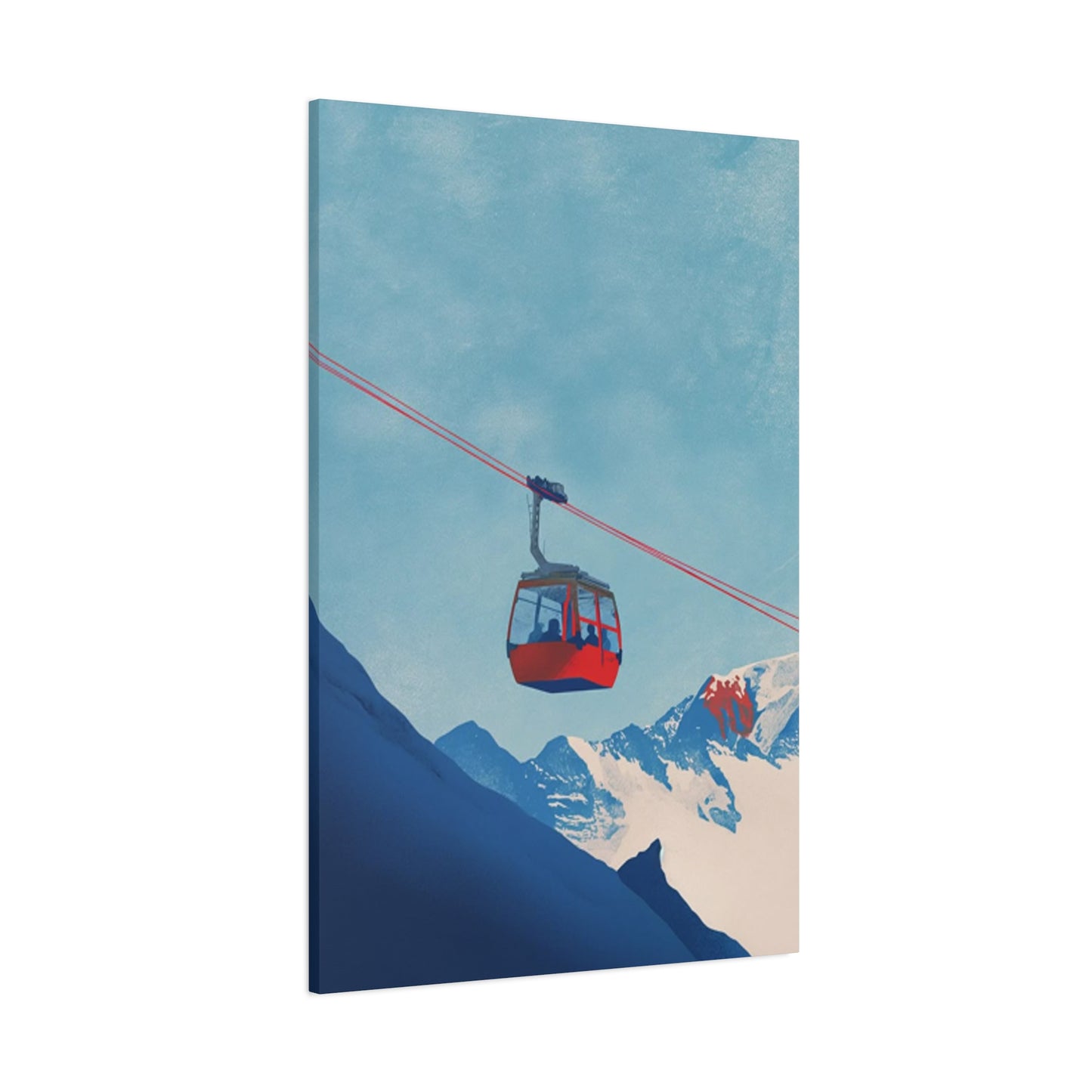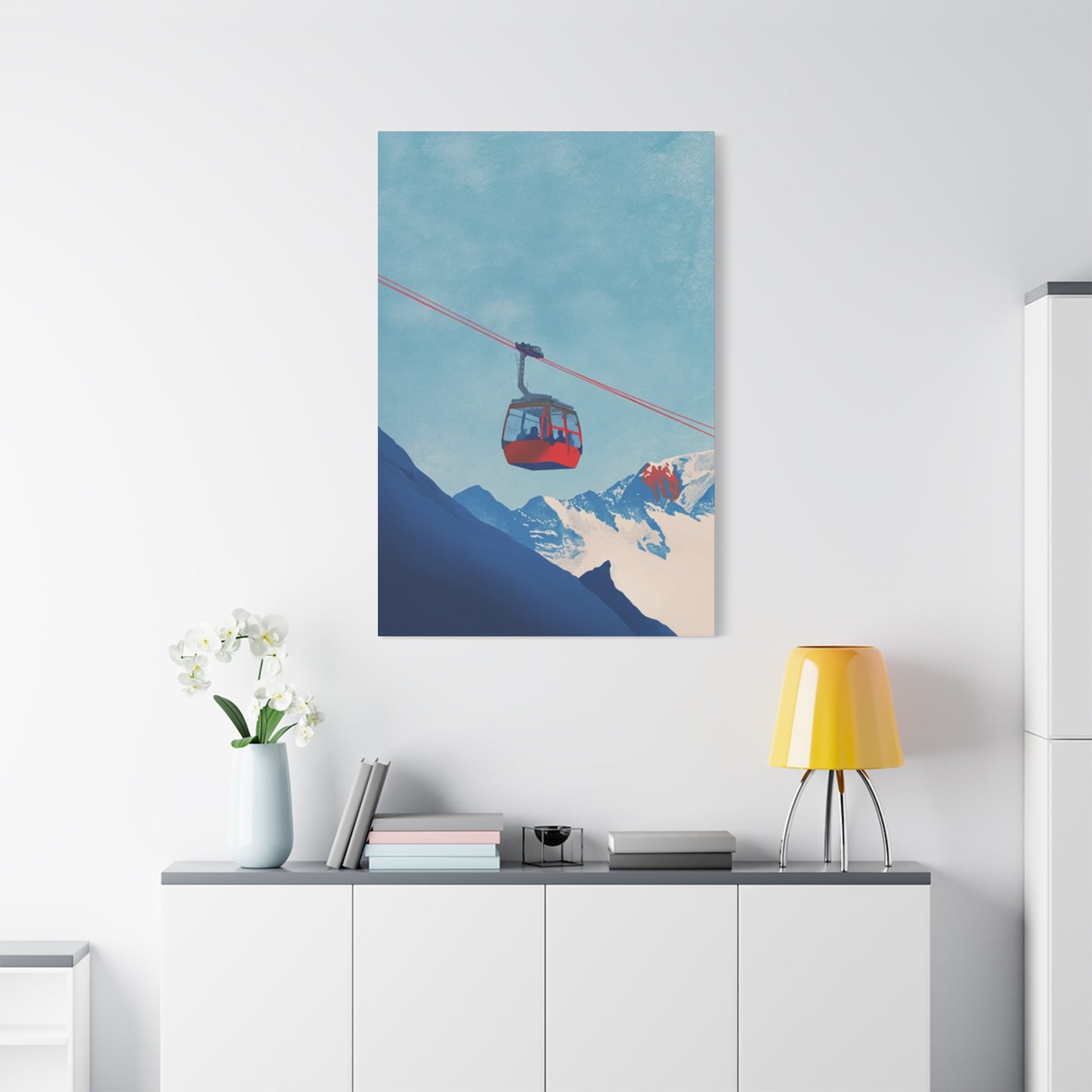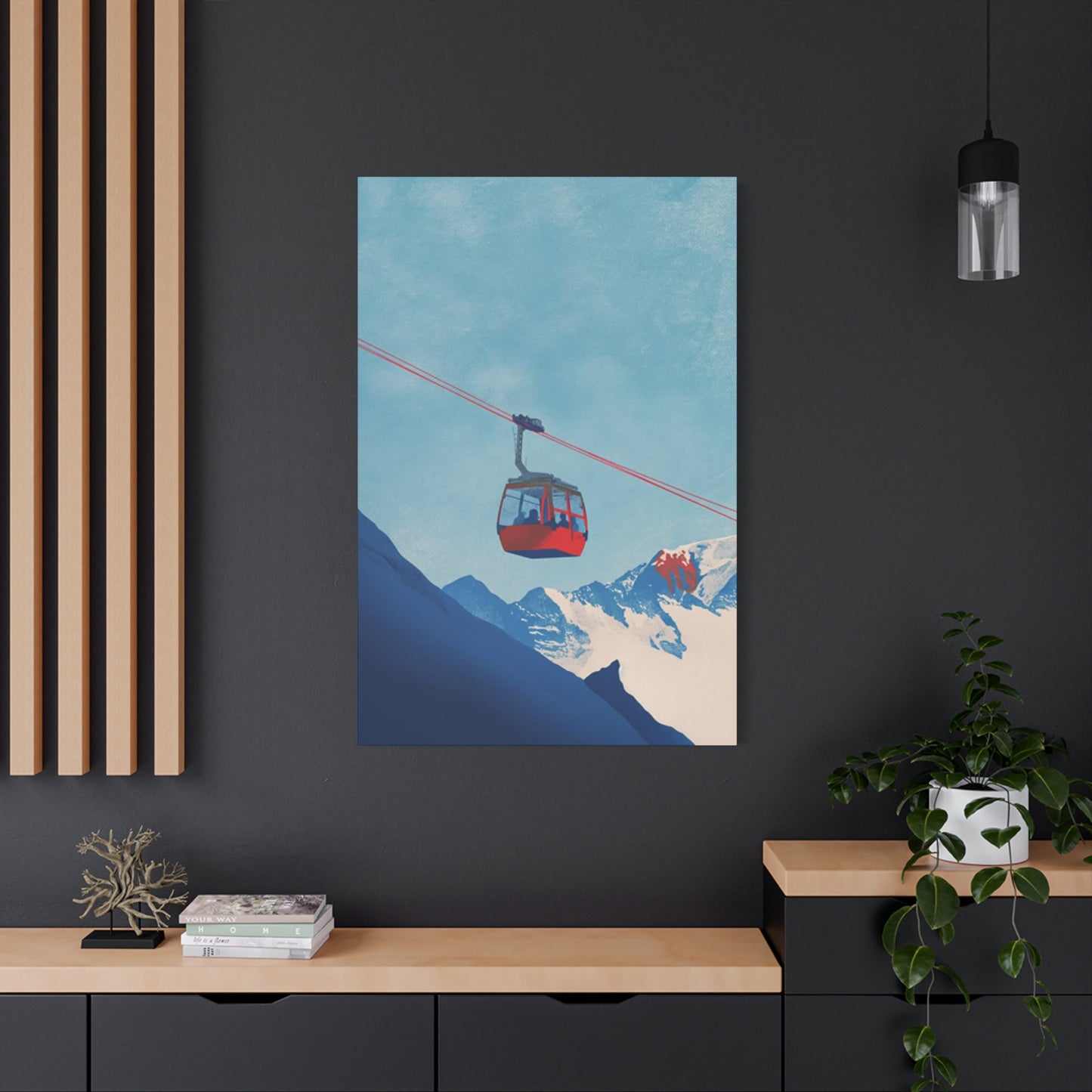Red Cable Car Wall Art: Mountain Journey Masterpieces for Your Home
Mountain landscapes have always captivated the human spirit, representing adventure, freedom, and the pursuit of breathtaking vistas. Among the most iconic elements of these elevated terrains are cable cars, those engineering marvels that gracefully traverse steep slopes and connect valleys to peaks. When adorned in vibrant red hues and transformed into artistic expressions, red cable car wall art becomes a powerful medium that brings the essence of mountain adventures directly into our living environments.
The allure of red cable car wall art extends far beyond mere decoration. These artistic pieces serve as windows to distant peaks, reminders of journeys taken or dreams yet to be realized, and symbols of humanity's endless quest to reach new heights. Whether rendered in abstract splashes of crimson and scarlet or captured in photorealistic detail, red cable car artwork transforms ordinary walls into gateways of inspiration and wanderlust.
The magnetic appeal of these mountain-themed artworks lies in their ability to evoke multiple emotions simultaneously. They represent progress and movement, the courage to ascend unknown paths, and the reward of spectacular panoramic views that await at journey's end. The distinctive red coloring adds warmth and energy to any room, creating focal points that draw the eye and spark conversations about adventure and exploration.
In today's fast-paced world, where many find themselves confined to urban environments, red cable car wall art serves as a powerful reminder of the natural world's majesty and the adventures that await beyond city limits. These artistic expressions provide visual escapes that can transport viewers mentally to crisp mountain air, snow-capped peaks, and the gentle swaying motion of ascending cable cars.
The versatility of red cable car wall art makes it suitable for various decorative themes and room settings. From rustic mountain cabins to contemporary urban apartments, these pieces can be seamlessly integrated to create atmosphere and visual interest. The bold red color palette ensures these artworks remain striking focal points while complementing a wide range of existing color schemes and decorative elements.
As we explore the multifaceted world of red cable car wall art, we'll discover how these pieces can transform living environments, inspire wanderlust, and serve as constant reminders of the beauty and adventure that mountain landscapes offer. Whether you're a seasoned mountain enthusiast or simply someone who appreciates the aesthetic appeal of these mechanical marvels, red cable car wall art provides an accessible way to bring the spirit of high-altitude adventure into your daily life.
The Symbolic Meaning Behind Cable Cars in Mountain Landscapes
Cable cars represent far more than simple transportation mechanisms; they embody humanity's relentless drive to conquer challenging terrain and reach seemingly impossible destinations. In mountain landscapes, these suspended vehicles become symbols of progress, ingenuity, and the human spirit's refusal to be limited by natural obstacles. When depicted in art, particularly in striking red hues, cable cars take on deeper symbolic meanings that resonate with viewers on both conscious and subconscious levels.
The symbolic power of cable cars stems from their unique position as bridges between earth and sky, valley and peak, the known and the unknown. They represent transition and transformation, carrying passengers from one realm to another, often revealing spectacular vistas that can only be appreciated from elevated perspectives. This transitional quality makes cable car imagery particularly powerful in artistic contexts, where it can represent personal journeys, life transitions, and the pursuit of higher aspirations.
In psychological terms, cable cars symbolize trust and faith in systems beyond our direct control. Passengers must surrender themselves to these mechanical marvels, trusting in engineering and maintenance while ascending to heights that would otherwise be inaccessible. This element of trust and surrender adds layers of meaning to cable car artwork, making these pieces especially meaningful for individuals navigating major life transitions or seeking inspiration for personal growth.
The red coloration commonly associated with cable car art amplifies these symbolic meanings. Red represents passion, energy, courage, and determination – qualities essential for mountain adventures and life journeys alike. The vibrant hue suggests warmth and vitality, creating visual connections between the viewer and the adventurous spirit represented by the ascending cable car. This color choice transforms functional transportation into symbols of life force and dynamic energy.
Mountain landscapes themselves carry profound symbolic weight, representing challenges to be overcome, goals to be achieved, and the rewards that come from persistent effort. Cable cars within these landscapes become symbols of the tools and methods we use to reach our objectives. They remind us that even the most daunting peaks can be conquered with proper planning, appropriate technology, and unwavering determination.
The suspended nature of cable cars adds another layer of symbolic interpretation. Hanging between earth and sky, these vehicles exist in a liminal space that represents the balance between grounding and aspiration. They suggest that achieving great heights requires both solid foundations and the willingness to leave familiar ground behind. This duality makes cable car imagery particularly powerful for individuals seeking motivation to pursue ambitious goals while maintaining connections to their roots.
Cultural interpretations of cable car symbolism vary across different societies, but common themes include progress, adventure, and the democratization of mountain access. These mechanical systems allow people of various ages and physical abilities to experience mountain heights that were previously reserved for experienced climbers. In this sense, cable cars symbolize inclusivity and the expansion of possibilities for human experience.
The rhythmic, steady movement of cable cars also represents persistence and consistency in pursuing long-term goals. Unlike the quick burst of energy required for climbing, cable car ascent is gradual and measured, suggesting that the most rewarding achievements often come through sustained effort rather than dramatic sprints. This symbolism resonates particularly strongly with individuals working toward career advancement, educational goals, or personal development objectives.
Environmental symbolism associated with cable cars includes the harmony between human engineering and natural landscapes. Well-designed cable car systems work with topography rather than against it, suggesting sustainable approaches to progress that respect natural constraints while still achieving human objectives. This environmental consideration adds contemporary relevance to cable car symbolism, particularly for environmentally conscious individuals.
The communal aspect of cable car travel introduces social symbolism into these artistic representations. Unlike solitary climbing experiences, cable car journeys are typically shared with other passengers, creating temporary communities of fellow travelers united by common destinations and shared experiences of ascent. This communal element suggests that our most meaningful journeys are often enhanced by connections with others who share similar aspirations.
Incorporating Red Cable Car Art with Rustic Mountain Decor
The marriage of red cable car art with rustic mountain decor creates harmonious environments that celebrate both natural beauty and human ingenuity. This combination successfully bridges the gap between wilderness authenticity and mechanical marvels, resulting in decorative schemes that feel both grounded in nature and inspired by adventure. The key to successful integration lies in understanding how the bold, industrial elements of cable car imagery can complement the organic, weathered textures typical of rustic mountain aesthetics.
Rustic mountain decor traditionally emphasizes natural materials, earth tones, and textures that reflect outdoor environments. Wood surfaces, stone accents, leather furnishings, and metal elements create foundations that readily accept the addition of red cable car artwork. The mechanical precision depicted in cable car art provides interesting contrast to the organic irregularities found in rustic elements, creating visual tension that keeps decorative schemes engaging rather than monotonous.
The red coloration in cable car artwork serves as an ideal accent color for rustic mountain palettes. Traditional rustic color schemes often rely heavily on browns, greens, and neutral tones, making the introduction of vibrant red particularly impactful. Red cable car art can serve as the primary color accent in otherwise neutral environments, or it can complement existing red elements such as plaid textiles, ceramic accents, or painted furniture details.
Textural considerations play crucial roles in successfully combining these decorative elements. The smooth, mechanical surfaces depicted in cable car art create compelling contrasts with rough-hewn wood beams, stone fireplaces, and woven textiles common in rustic settings. This textural diversity prevents rustic environments from appearing too uniform while maintaining overall cohesive aesthetic appeal.
Scale relationships between cable car artwork and rustic furnishings require careful consideration. Large-scale cable car paintings or prints can serve as dramatic focal points above substantial furniture pieces like leather sofas or wooden dining tables. Smaller cable car artworks work well in groupings or as accent pieces that complement rather than dominate rustic decorative schemes. The key is achieving balance between the industrial precision of cable car imagery and the organic irregularities of rustic elements.
Lighting considerations become particularly important when displaying red cable car art in rustic mountain settings. The warm tones typically used in rustic lighting schemes can enhance the red hues in cable car artwork while creating atmospheric effects that suggest mountain lodge environments. Strategic placement of artwork in relation to natural light sources, fireplaces, or warm artificial lighting can dramatically impact how red cable car pieces interact with surrounding rustic elements.
Frame selection for red cable car artwork in rustic settings should complement rather than compete with existing decorative elements. Weathered wood frames, wrought iron frames, or simple black metal frames typically work well with rustic mountain decor. Ornate or highly polished frames can create disconnection between artwork and surrounding rustic elements, disrupting the overall decorative harmony.
The integration of red cable car art with specific rustic mountain furnishings creates opportunities for thematic storytelling within decorative schemes. Vintage ski equipment, hiking gear, or camping accessories displayed alongside cable car artwork reinforce themes of mountain adventure and outdoor exploration. These combinations create environments that feel authentic to mountain culture while celebrating the mechanical innovations that make mountain access possible.
Seasonal considerations add another dimension to combining red cable car art with rustic mountain decor. The vibrant red colors in cable car artwork can provide welcome warmth during winter months when rustic environments might otherwise feel cold or stark. During warmer seasons, the same artwork can suggest adventure and exploration, encouraging thoughts of summer mountain excursions and scenic cable car rides.
Room-specific applications of this decorative combination vary based on functional requirements and atmospheric goals. Living rooms benefit from large-scale red cable car artwork that serves as conversation starters and focal points. Bedrooms might feature smaller, more intimate cable car pieces that suggest dreams of mountain adventures. Dining areas can incorporate cable car art that complements the communal aspects of mountain lodge dining experiences.
The psychological impact of combining red cable car art with rustic mountain decor creates environments that feel both grounding and inspiring. The rustic elements provide stability and connection to natural environments, while the cable car imagery suggests possibility and adventure. This combination appeals to individuals who value both comfort and exploration, creating living environments that support both relaxation and aspiration.
Exploring Abstract Versus Realistic Red Cable Car Paintings
The artistic interpretation of red cable cars offers fascinating opportunities for exploring different stylistic approaches, with abstract and realistic renderings each providing unique advantages and aesthetic appeals. The choice between abstract and realistic cable car paintings significantly impacts how these artworks function within decorative schemes and how they communicate their intended messages to viewers. Understanding these differences helps art enthusiasts select pieces that best align with their aesthetic preferences and decorative objectives.
Realistic red cable car paintings focus on accurate representation, capturing specific details of cable car mechanisms, mountain landscapes, and atmospheric conditions. These works often showcase technical artistic skills while providing viewers with recognizable imagery that immediately communicates the subject matter. Realistic cable car paintings can transport viewers to specific locations, evoke memories of particular cable car experiences, or inspire dreams of visiting depicted mountain destinations.
The appeal of realistic red cable car artwork lies in its immediate accessibility and universal recognition. Viewers don't need artistic interpretation skills to appreciate these pieces; the subject matter is immediately apparent and emotionally engaging. Realistic paintings can showcase the intricate engineering details of cable car systems, the breathtaking beauty of mountain landscapes, and the interplay between human technology and natural environments with photographic precision.
Technical considerations in realistic cable car paintings include accurate perspective, proper color relationships, and convincing lighting effects. Artists working in realistic styles must master traditional painting techniques while carefully observing their cable car subjects to ensure accuracy. The challenge lies in capturing not just the physical appearance of cable cars and mountain settings, but also the atmospheric qualities that make these scenes emotionally compelling.
Abstract red cable car paintings, conversely, prioritize emotional expression and artistic interpretation over literal representation. These works may reduce cable car imagery to essential forms, colors, and movements that suggest rather than explicitly depict their subjects. Abstract approaches allow artists to emphasize particular aspects of the cable car experience, such as the sensation of movement, the emotional impact of ascending heights, or the relationship between mechanical precision and natural chaos.
The freedom inherent in abstract cable car art enables artists to experiment with color relationships, compositional structures, and textural effects that might not exist in realistic mountain settings. Vibrant reds can dominate compositions, creating emotional intensity that may be more powerful than realistic color relationships. Abstract works can capture the essence of cable car experiences while allowing viewers to project their own memories and associations onto the artwork.
Viewing abstract cable car paintings requires more active engagement from audiences, as these works invite interpretation and personal reflection rather than simple recognition. This quality can make abstract pieces more engaging over time, as viewers may discover new meanings and visual relationships with repeated viewings. Abstract cable car art can evolve with viewers' changing life experiences, maintaining relevance and emotional impact across different life stages.
The decorative applications of abstract versus realistic cable car paintings vary based on room functions and atmospheric goals. Realistic cable car artwork often works well in areas where conversation and recognition are valued, such as living rooms or dining areas. Abstract cable car pieces may be more suitable for private contemplative areas like bedrooms or studies, where personal reflection and emotional response take precedence over social recognition.
Color intensity and distribution differ significantly between abstract and realistic cable car paintings. Realistic works must maintain color relationships that appear convincing within natural lighting conditions, while abstract pieces can push color intensity to emotional extremes. This difference affects how these artworks interact with room lighting and existing color schemes.
Scale considerations also vary between abstract and realistic cable car paintings. Realistic works often benefit from scales that allow viewers to appreciate detailed elements, while abstract pieces can work effectively at various scales, from intimate small canvases to dramatic large-scale installations. The effectiveness of abstract cable car art often depends more on color impact and compositional strength than on detailed recognition.
The longevity of aesthetic appeal may differ between abstract and realistic cable car paintings. Realistic works may provide immediate satisfaction but could become familiar over time, while abstract pieces might initially challenge viewers but provide ongoing discovery and interpretation opportunities. This difference influences decisions about artwork placement and long-term decorative planning.
Market considerations reflect different audience preferences for abstract versus realistic cable car art. Realistic pieces often appeal to broader audiences, including individuals who may be intimidated by abstract art. Abstract cable car paintings typically attract viewers who appreciate artistic experimentation and personal interpretation opportunities.
Techniques for Capturing Motion in Red Cable Car Wall Art
The depiction of movement represents one of the most challenging and rewarding aspects of creating compelling red cable car wall art. Cable cars exist in a state of constant motion, gracefully traversing mountain landscapes with rhythmic precision that artists must capture to create dynamic, engaging artworks. Successfully rendering this sense of movement requires mastering various artistic techniques that can transform static paintings into visual experiences that suggest speed, direction, and the kinetic energy inherent in cable car travel.
Traditional motion blur techniques offer one approach to capturing cable car movement in artistic renderings. By slightly blurring elements of the cable car itself while maintaining sharp focus on stationary landscape elements, artists can suggest the passage of the vehicle through mountain terrain. This technique requires careful balance, as excessive blur can make cable cars unrecognizable, while insufficient blur fails to convey movement effectively.
Directional brushwork provides another powerful tool for suggesting cable car motion. Strategic brush strokes that follow the direction of cable car travel can create visual momentum that draws viewers' eyes along the path of movement. This technique works particularly well in abstract or semi-abstract cable car paintings, where brushwork can become an integral part of the compositional structure rather than simply a rendering technique.
The use of multiple cable car positions within single compositions can effectively communicate movement through sequential imagery. By depicting the same red cable car at different points along its route, artists can create visual narratives that suggest the progression of ascent or descent. This technique works particularly well in panoramic formats that accommodate the horizontal movement typical of cable car systems.
Color gradation techniques can enhance the sense of motion in red cable car artwork. By subtly shifting the intensity or hue of red coloring as cable cars move through compositions, artists can suggest the effects of changing atmospheric conditions and lighting that occur during actual cable car journeys. These color shifts can also imply speed and direction, with cooler tones suggesting areas where cable cars have passed and warmer tones indicating current positions.
Atmospheric perspective techniques contribute significantly to motion depiction in cable car art. By showing how cable cars interact with mountain mists, clouds, or changing weather conditions, artists can suggest movement through three-dimensional environments. The way atmospheric elements part around moving cable cars or trail behind them can powerfully communicate kinetic energy.
Compositional line work plays crucial roles in motion capture. Strong diagonal lines that follow cable routes create visual pathways that guide viewers' eyes and suggest directional movement. These compositional elements can be reinforced through landscape features, cable line placement, and even cloud formations that echo the directional thrust of cable car travel.
Tension and release techniques within compositions can suggest the rhythmic nature of cable car movement. Areas of visual compression followed by expansive sections can mirror the way cable cars navigate varying terrain, creating visual rhythms that echo the mechanical rhythms of actual cable car systems. This approach requires careful compositional planning to achieve effective pacing.
The depiction of supporting cables and pulleys offers opportunities to suggest mechanical motion through precise rendering of these functional elements. Showing the interaction between moving cable cars and their support systems can communicate the technical aspects of motion while adding authentic details that reinforce the mechanical nature of these transportation systems.
Kinetic energy can be suggested through the positioning of secondary elements within cable car compositions. Birds in flight, moving clouds, swaying trees, or flowing water can create environmental context that reinforces the sense of movement associated with cable car travel. These elements can provide motion cues that support the primary focus on cable car movement.
Light and shadow patterns can effectively communicate motion, particularly when showing how moving cable cars interact with changing lighting conditions during their journeys. The way shadows fall from moving cable cars, or how light reflects off their surfaces as they change position and orientation, can provide powerful visual cues about movement and direction.
The emotional aspects of motion in cable car art shouldn't be overlooked. The sense of anticipation, excitement, and gradual revelation that characterizes actual cable car journeys can be suggested through artistic techniques that create visual tension and release. This emotional component of motion may be more important than literal accuracy in creating engaging cable car artwork.
Experimental techniques for motion capture might include unconventional approaches such as intentional camera shake effects in photographic references, multiple exposure techniques, or even digital manipulation methods that can then be interpreted through traditional painting techniques. These experimental approaches can lead to innovative solutions for the challenge of depicting cable car motion.
Optimal Locations for Displaying Red Cable Car Mountain Art
The placement of red cable car mountain art significantly influences both its visual impact and its ability to enhance living environments. Strategic positioning can transform these artworks from simple decorative elements into powerful focal points that define room atmospheres and create lasting impressions on residents and visitors alike. Understanding the principles of effective art placement ensures that red cable car paintings achieve maximum aesthetic and emotional impact while complementing existing architectural features and decorative elements.
Living room placement offers perhaps the most versatile opportunities for displaying red cable car mountain art. The central role of living rooms in home social dynamics makes them ideal locations for conversation-starting artwork that can engage visitors and reflect homeowners' interests and values. Above seating areas, red cable car art can create compelling focal points that draw attention without overwhelming intimate conversation settings.
The relationship between artwork scale and room proportions becomes particularly important in living room applications. Large-scale red cable car paintings work well in spacious living rooms with high ceilings, where they can command attention without dominating the environment. Smaller living rooms may benefit from medium-sized pieces or groupings of smaller works that create visual interest without overwhelming limited wall area.
Lighting considerations in living rooms directly impact how red cable car art appears throughout different times of day and various lighting conditions. Natural light from windows can dramatically enhance the vibrant red colors in cable car artwork during daytime hours, while evening artificial lighting creates different atmospheric effects that may emphasize different aspects of the same pieces.
Dining room placement of red cable car mountain art can create inspiring atmospheres that enhance meal experiences and social gatherings. The communal nature of dining spaces aligns well with the shared experience aspects of cable car travel, creating thematic connections that add depth to decorative schemes. Dining rooms typically offer wall areas that are visible from multiple seating positions, ensuring that red cable car artwork can be appreciated from various perspectives.
The horizontal format common in many cable car mountain paintings works particularly well in dining room settings, where horizontal wall areas above buffets, sideboards, or along extended walls can accommodate panoramic mountain vistas. These horizontal orientations can visually expand dining rooms while providing scenic backdrops for meal experiences.
Bedroom applications of red cable car mountain art require different considerations than public room placements. The intimate nature of bedroom environments suggests that cable car artwork should inspire dreams and personal reflection rather than serve primarily as social conversation pieces. Softer, more contemplative cable car images may work better in bedroom settings than dynamic, high-energy pieces.
The psychological impact of bedroom artwork placement influences sleep quality and morning inspiration. Red cable car art positioned where it's visible upon waking can provide daily motivation and adventure inspiration, while pieces placed opposite beds can offer contemplative focal points for evening reflection before sleep.
Home office and study placements of red cable car mountain art can provide inspirational elements that combat the potential monotony of work environments. The symbolism of ascension and achievement inherent in cable car imagery makes these artworks particularly appropriate for work areas where goal achievement and progress are valued.
The positioning of cable car art in relation to work areas should consider both inspiration and distraction factors. Artwork placed within direct sightlines of computer screens or desks should inspire rather than distract from work activities. Strategic positioning can provide inspirational breaks when attention naturally shifts from work tasks.
Hallway and transitional area placements offer opportunities to create visual journeys that echo the travel themes inherent in cable car artwork. Sequences of related cable car pieces along hallways can create narrative progressions that enhance the experience of moving through home environments.
Stairway placements can particularly effective for cable car mountain art, as the ascending nature of stairs creates natural thematic connections with cable car ascension imagery. The changing viewing angles available on stairways can be utilized to create dynamic viewing experiences that reveal different aspects of cable car artwork as viewers ascend or descend.
Kitchen applications of red cable car art should consider the practical demands of cooking environments while providing visual interest that enhances daily meal preparation activities. The warmth of red coloring in cable car artwork can complement kitchen environments while providing visual escapes from routine domestic tasks.
Bathroom placements, while less common, can create unexpected moments of inspiration and visual interest. Smaller cable car pieces or prints can transform utilitarian bathroom environments into more personally meaningful areas that reflect homeowners' adventure interests and aesthetic preferences.
Seasonal rotation strategies can maximize the impact of red cable car mountain art collections. Different pieces can be displayed during various seasons to complement changing outdoor conditions and indoor decorative adjustments. Winter displays might emphasize snowy mountain cable car scenes, while summer rotations could feature clearer weather mountain vistas.
Creative DIY Red Cable Car Painting Techniques and Projects
Creating original red cable car paintings offers rewarding opportunities for artistic expression while developing personalized artworks that perfectly match individual aesthetic preferences and decorative requirements. DIY cable car painting projects can range from simple beginner exercises to complex artistic endeavors that challenge experienced painters to develop new skills and techniques. The key to successful DIY cable car art lies in understanding fundamental painting principles while embracing creative experimentation that can lead to unique artistic discoveries.
Preparation stages for DIY cable car painting projects begin with gathering appropriate reference materials and artistic supplies. Photographic references of cable cars in mountain settings provide essential visual information for both realistic and abstract interpretations. Multiple reference images from different angles and lighting conditions offer comprehensive understanding of cable car proportions, mechanical details, and environmental contexts.
Canvas selection significantly impacts the final appearance and longevity of DIY cable car paintings. Traditional stretched canvases work well for most projects, but alternative surfaces such as canvas boards, wood panels, or even textured papers can provide different aesthetic effects. The choice of painting surface should align with intended display locations and desired artistic effects.
Color palette development represents a crucial early step in DIY cable car painting projects. While red serves as the primary cable car color, successful paintings require carefully planned supporting colors that represent mountain landscapes, sky conditions, and atmospheric effects. Limited color palettes often produce more cohesive results than attempting to use every available color.
Basic composition planning helps ensure successful outcomes in DIY cable car painting projects. Simple sketching exercises can help determine optimal cable car positioning, landscape elements, and overall compositional balance before committing paint to canvas. These preliminary sketches also provide opportunities to experiment with different artistic approaches and stylistic choices.
Underpainting techniques provide solid foundations for DIY cable car paintings. Starting with broad color areas and gradually adding details allows painters to establish overall color relationships and compositional structures before focusing on specific elements. This approach reduces the risk of overworking early stages while maintaining flexibility for artistic adjustments.
Layering strategies enable DIY painters to build complexity gradually while maintaining control over artistic development. Starting with background mountain landscapes and progressively adding cable car elements allows each layer to dry properly while preventing muddy color mixing that can result from working wet paint into wet paint.
Brushwork techniques specifically applicable to cable car subjects include methods for rendering mechanical precision alongside natural organic forms. Different brush types serve different purposes in cable car paintings, from fine detail brushes for cable lines and mechanical elements to broader brushes for mountain landscapes and atmospheric effects.
Color mixing techniques for achieving vibrant red cable car colors require understanding how different red pigments behave in various mixtures. Some red pigments maintain vibrancy when mixed with other colors, while others become muddy or dull. Experimentation with color mixing on separate surfaces before applying to paintings prevents unwanted color surprises.
Texture creation techniques can add visual interest and authenticity to DIY cable car paintings. Methods for suggesting metal surfaces, glass windows, cable materials, and various mountain landscape textures can enhance the overall realism and visual appeal of finished paintings.
Abstract interpretation approaches for DIY cable car paintings allow painters to focus on emotional expression rather than literal accuracy. These techniques might include color field approaches that emphasize the feelings associated with cable car experiences, or gestural techniques that capture the essence of movement and ascension.
Detail addition strategies help painters determine when sufficient detail has been achieved and when additional work might detract from overall artistic impact. The tendency to over-detail paintings can be avoided by regularly stepping back to evaluate overall compositions and focusing on elements that contribute most significantly to intended artistic messages.
Problem-solving techniques for common DIY painting challenges include methods for correcting mistakes, adjusting color relationships, and modifying compositions that aren't developing as intended. Understanding that paintings can be modified and improved reduces anxiety while encouraging creative experimentation.
Finishing techniques for DIY cable car paintings include varnishing options that protect finished works while enhancing color vibrancy. Different varnish types produce different surface effects, from matte finishes that reduce reflections to glossy finishes that intensify colors.
Project documentation through photography provides records of artistic development while creating reference materials for future projects. Documenting various stages of painting development can help identify successful techniques and approaches that can be applied to subsequent cable car painting projects.
Framing and display considerations for DIY cable car paintings should be planned during early project stages to ensure finished works integrate successfully with intended display environments. Frame selection can significantly impact how DIY paintings appear in their final display contexts.
Skill development progression through sequential DIY cable car painting projects allows painters to gradually tackle more complex artistic challenges. Starting with simpler compositions and gradually attempting more ambitious projects provides manageable skill development pathways that build confidence while expanding artistic capabilities.
Historical Evolution of Cable Cars in Mountain Art
The representation of cable cars in mountain art reflects both technological advancement and changing cultural attitudes toward mountain environments and mechanized transportation. From their earliest appearances in late 19th-century illustrations to contemporary artistic interpretations, cable cars have evolved from utilitarian subjects to powerful symbols of human ingenuity and adventure seeking. This historical progression reveals shifting perspectives on the relationship between technology and nature, progress and preservation, accessibility and exclusivity in mountain environments.
Early cable car depictions in mountain art emerged during the late 1800s as these transportation systems began appearing in European Alpine regions and American mountain destinations. Initial artistic representations focused primarily on documentation rather than aesthetic interpretation, with illustrations serving promotional and educational purposes for tourism development and engineering achievement celebration. These early works emphasized the novelty and mechanical sophistication of cable car systems.
The documentary approach of early cable car art reflected contemporary attitudes toward technological progress and mountain accessibility. Artists of this period viewed cable cars as symbols of human triumph over natural obstacles, representing civilization's ability to make previously inaccessible mountain regions available to broader populations. These works typically portrayed cable cars as harmonious additions to mountain landscapes rather than intrusions upon natural environments.
Photographic influences on cable car art became increasingly significant as camera technology developed during the early 20th century. Photographic accuracy standards began influencing artistic representations, with painters striving to capture specific lighting conditions, atmospheric effects, and mechanical details with increasing precision. This photographic influence contributed to the development of more realistic cable car artistic traditions.
Tourism industry connections played crucial roles in shaping cable car art throughout the early to mid-20th century. Resort destinations commissioned artwork featuring cable cars as marketing tools to attract visitors and convey messages about accessibility and adventure. These commercial applications influenced artistic styles, with emphasis placed on attractive, inviting representations that would appeal to potential tourists.
The romanticization of cable car travel emerged as these systems became established parts of mountain tourism infrastructure. Artists began emphasizing the scenic and emotional aspects of cable car journeys rather than focusing primarily on mechanical or promotional elements. This shift reflected changing cultural attitudes that valued experience and adventure over purely technological achievement.
World War impact on cable car art revealed the strategic and military significance these transportation systems acquired during conflict periods. Some cable car systems served military purposes, leading to artistic representations that emphasized their strategic value and contribution to war efforts. Post-war art often reflected themes of reconstruction and renewed accessibility to mountain regions.
Mid-century modern influences on cable car art introduced cleaner lines, simplified forms, and emphasis on design elements that reflected contemporary aesthetic trends. Artists working in modern styles found cable car subjects particularly compatible with geometric composition approaches and emphasis on functional beauty that characterized mid-20th century design movements.
Environmental awareness impacts on cable car art became increasingly apparent during the latter half of the 20th century as ecological consciousness developed. Some artists began depicting cable cars as intrusions upon natural environments, while others portrayed them as examples of sustainable transportation that minimized environmental impact compared to alternative mountain access methods.
Contemporary cable car art reflects complex relationships between technology, environment, and human experience. Current artists often explore themes of sustainability, accessibility, and the role of mechanical systems in connecting people with natural environments. These works may celebrate technological achievement while acknowledging environmental considerations and social equity issues related to mountain access.
Cultural variation in cable car art traditions reflects different national and regional attitudes toward mountain environments and technological intervention. Swiss and Austrian cable car art often emphasizes harmony between human engineering and Alpine environments, while American interpretations may focus more on conquest and achievement themes.
The evolution of cable car artistic techniques parallels developments in broader art movements and technical capabilities. From early watercolor illustrations to contemporary digital art interpretations, cable car subjects have been adapted to various artistic media and stylistic approaches, demonstrating the flexibility of these subjects across different artistic contexts.
Collector interest in historical cable car art has created markets for both original works and high-quality reproductions of significant pieces. This collecting activity has contributed to preservation of cable car art history while maintaining public awareness of the cultural significance these artworks represent.
Contemporary reinterpretation of historical cable car art themes allows modern artists to engage with traditional subjects while addressing current concerns and aesthetic preferences. These reinterpretations may update color palettes, composition approaches, or thematic emphasis while maintaining connections to historical cable car art traditions.
The digital age impact on cable car art includes both new creation tools and new distribution methods that have democratized both artistic creation and access to cable car art collections. Digital reproduction capabilities have made historical cable car artworks more widely available while digital creation tools have enabled new experimental approaches to cable car subjects.
Red Cable Car Art as Symbols of Travel and Freedom
Red cable car art functions as powerful visual metaphors for travel aspirations and personal freedom, transcending their literal representation as mountain transportation to become symbols of liberation from routine constraints and access to extraordinary experiences. The psychological and emotional associations embedded in these artworks tap into fundamental human desires for exploration, adventure, and the transcendence of daily limitations. Understanding these symbolic dimensions enhances appreciation for why red cable car art resonates so strongly with viewers seeking inspiration and motivation in their living environments.
The freedom symbolism inherent in cable car imagery stems from their ability to transport passengers beyond ordinary terrestrial limitations. Unlike ground-based transportation that must navigate around obstacles, cable cars ascend directly over challenging terrain, providing metaphorical representations of rising above life's difficulties and achieving elevated perspectives. This vertical movement suggests liberation from earthbound constraints and access to previously unreachable goals.
Travel associations connected to red cable car art evoke memories of vacation experiences while inspiring dreams of future adventures. For individuals who have experienced cable car journeys, these artworks can trigger vivid recollections of specific mountain destinations, weather conditions, and emotional states associated with those travels. For others, cable car art represents possibilities for future adventures and destinations yet to be explored.
The red coloration specifically enhances the freedom and travel symbolism by adding emotional intensity and energy to cable car imagery. Red suggests passion for adventure, courage to pursue challenging experiences, and the vital life force that drives exploration and discovery. This color choice transforms mechanical transportation devices into symbols of dynamic living and enthusiastic engagement with life's possibilities.
Psychological escape mechanisms provided by red cable car art allow viewers to mentally transport themselves from current environments to imagined mountain destinations. This mental transportation can provide temporary relief from stress, inspiration for future planning, and emotional connections to natural environments that may be physically inaccessible due to geographic or circumstantial limitations.
The democratization themes represented by cable cars in art reflect their historical role in making mountain environments accessible to individuals who might not otherwise have physical capabilities or resources to reach high-altitude destinations. This accessibility symbolism makes cable car art particularly meaningful for individuals who value inclusivity and equal access to natural beauty and transformative experiences.
Temporal freedom concepts associated with cable car travel distinguish these experiences from rushed modern transportation methods. Cable car journeys typically involve gradual ascents that allow passengers to observe changing landscapes and weather conditions, representing more contemplative approaches to travel that emphasize experience over efficiency. This temporal aspect suggests freedom from hurried modern lifestyles.
Conclusion
Red cable car wall art captures the exhilarating spirit of mountain journeys, bringing a bold splash of color and adventure into your living space. The iconic imagery of a red cable car ascending rugged peaks or gliding over scenic valleys evokes feelings of exploration, freedom, and the thrill of discovery. As a decorative piece, this artwork transforms your home into a tribute to nature’s grandeur and the timeless allure of mountain travel.
The striking contrast of the vivid red cable car against the often serene, majestic backdrop of mountains creates a dynamic visual impact. Whether depicted in crisp realism, impressionistic brushstrokes, or stylized graphic design, the art conveys motion and perspective, inviting viewers to imagine themselves on the ride—soaring above treetops, clouds, and breathtaking landscapes. This sense of movement and elevation adds depth and energy to any room.
Red cable car wall art is also a wonderful symbol of journey and progress, making it more than just a scenic depiction. It represents overcoming obstacles, reaching new heights, and embracing the beauty found along life’s paths. For many, such art resonates as a reminder of personal growth and the excitement of new experiences, perfectly suited for spaces where inspiration and reflection are encouraged.
From a design perspective, these masterpieces complement a variety of interiors—mountain lodges, urban apartments with a touch of wanderlust, or eclectic homes seeking a pop of color and adventure. Their bold hues and scenic compositions can become focal points above a fireplace, in a hallway, or as part of a curated gallery wall, adding both warmth and vitality.
In conclusion, red cable car wall art is a captivating addition to any home, blending the majesty of nature with the spirit of adventure. It elevates your décor with vivid color, compelling stories, and a sense of journey that inspires and invigorates daily life.

















